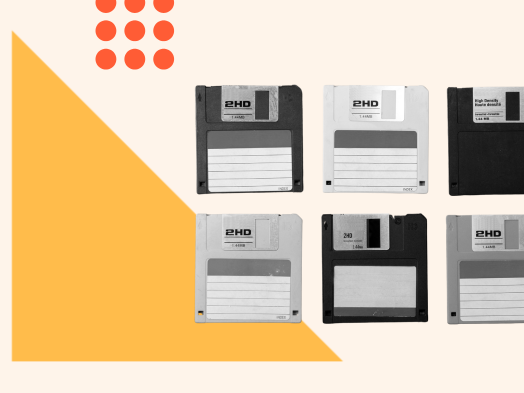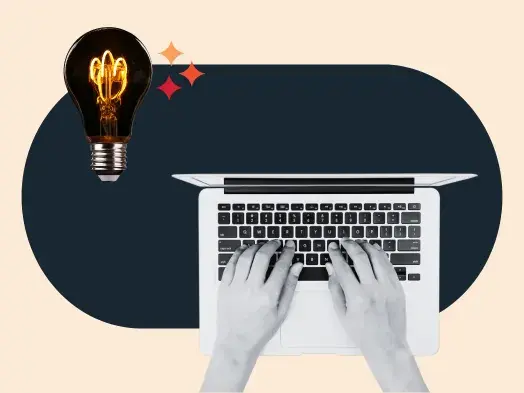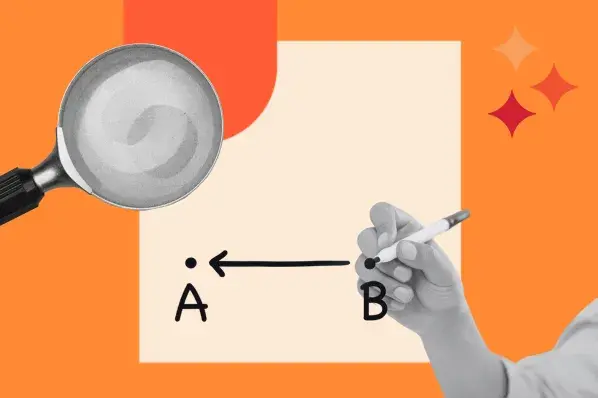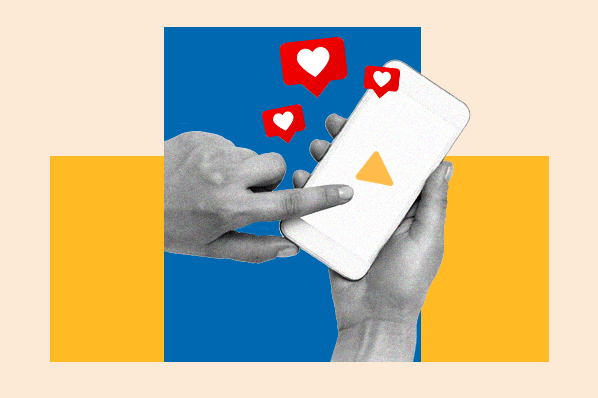At one SaaS company I worked with, we were proud of our output — dozens of “how-to” blog posts that pulled in steady traffic. But when I looked closer at the analytics, those posts weren’t converting at all. We were filling the calendar, not moving people closer to a decision.
It finally dawned on me that there’s a big difference between content that gets clicks and content that moves buyers forward. Pair the right asset with the right stage of the journey, and you create momentum that leads to sales.
In this post, I’ll walk you through the three stages of the content marketing funnel, the kinds of content that work best for each, and how to make sure every piece you create helps your audience take the next step.
Table of Contents
- What is the content marketing funnel?
- Levels of the Content Marketing Funnel
- Understanding the Buyer’s Journey in Marketing
- Why Creating Content for the Buyer's Journey Is Important
- Creating Content for Each Stage of the Buyer's Journey
- Content Ideas for Each Stage of the Buyer's Journey
What is the content marketing funnel?
The content marketing funnel is a way to organize content by where someone is in their buying journey — from first recognizing a problem to making a purchase decision.
It’s typically divided into three stages: top, middle, and bottom. Each one calls for a different type of content based on what the audience needs to move forward.
When I develop a content strategy, the funnel is one of the first things I map out. It helps me visualize how people move from awareness to action — and makes sure I’m not skipping any stage. Creating content that aligns with each step means I can meet buyers where they are, not where I wish they were. That’s what builds trust and momentum.
Levels of the Content Marketing Funnel
Each funnel stage needs a distinct approach because what buyers need early on differs dramatically from what they need when they're ready to decide.
That said, modern buyer journeys aren't linear.
Google and BCG suggest marketers should map influence based on behaviors — like how people stream, scroll, search, and shop — rather than relying on traditional funnel stages. I think that’s a smart evolution, and one that reflects how messy decision-making is today.
According to G2's 2024 Buyer Behavior Report, which surveyed nearly 2,000 B2B decision-makers, buyers strongly prefer self-service throughout most stages of their purchasing process. In fact, 69% of buyers typically engage with salespeople only after they‘ve already made their decision. This means your content for every funnel stage needs to work harder to influence decisions when you’re not in the room.
I still use the funnel as a planning tool because it keeps me focused on covering every stage — even when people don't move through it in a straight line.
Let’s start at the top.
Top of the Funnel (ToFu)
At the top of the funnel, people are just starting to realize something‘s not working. Maybe their team productivity is slipping, or they’re missing deadlines, but they can‘t quite put their finger on why. They’re not shopping for solutions yet — they're trying to figure out what the actual problem is.
This stage is where I create content that helps them connect the dots. I want to give them language for what they‘re experiencing and help them understand why it’s worth addressing. At this stage, I‘m not trying to sell anything — I’m trying to be genuinely helpful so they remember us when they're ready to explore solutions.
ToFu content includes:
- Blog posts addressing target customers’ everyday struggles
- Infographics showcasing industry statistics
- LinkedIn posts sharing quick strategy tips
- Short videos explaining industry trends
Middle of the Funnel (MoFu)
In the middle of the funnel, prospects actively research their options. They've defined their problem and are exploring solutions — comparing social media management tools, reading reviews, and evaluating how your offering stacks up.
Now I‘m focused on proving we know what we’re talking about. People at this stage have done enough research to ask thoughtful questions, and they want to see evidence that we can deliver. I spend time on content that demonstrates our expertise — case studies showing real results, honest comparisons that acknowledge trade-offs, and in-depth guides that go beyond surface-level advice.
MoFu content includes:
- In-depth guides with actionable tips
- Case studies highlighting customer success
- Detailed social media posts exploring specific challenges
- Comparison charts showing product differences
Bottom of the Funnel (BoFu)
At the bottom, buyers are nearly ready to act — they've done their research and need that final confidence boost to move forward.
By this stage, most people have already decided they want to solve their problem — now they're just picking who to work with. The content I create here is all about reducing risk and making the decision easier.
When someone can try the product for free or see precisely how much money they‘ll save, suddenly saying yes doesn’t feel like such a big leap.
BoFu content includes:
- Free audits, trials, or strategy consultations
- Testimonials from satisfied customers
- Live demos showing product value
- Discounts or limited-time offers
Understanding the Buyer’s Journey in Marketing
In my experience with B2B clients, the buyer‘s journey is rarely a linear process. People don’t discover a problem, read one blog post, and request a demo the next day. They move forward in fits and starts — researching, pausing, circling back — especially for complex or high-cost decisions.
That‘s why I treat the buyer’s journey as a layered process with three stages: awareness, consideration, and decision. Each maps to how people think and what they need at specific moments.

Take a startup I worked with whose project management was spiraling. Tools were scattered, deadlines missed, and no one could see the big picture. They weren't immediately searching for software. Like most buyers, they began by looking for guidance — articles on improving team alignment, templates for better planning, and advice on regaining project visibility.
My job is supporting that process with strategic content for every funnel stage — content that helps them define problems, explore solutions, and feel confident about next steps.
Awareness Stage
In the awareness stage, buyers notice a problem but may not have the language to describe it yet. They know something‘s not working and want to understand what’s happening and whether it's worth solving.
The awareness stage is where I focus on content that helps define the problem. That might be a blog post breaking down a common challenge, a self-assessment checklist, or a short video validating what they're experiencing.
Content Marketing Funnel Example
Early searches might sound like: “how to improve team productivity” or “why projects keep going off track.” These queries aren‘t about tools — they’re about making sense of situations. Meeting someone here with useful, unbiased content builds trust that carries into the next stage.
Consideration Stage
By the consideration stage, buyers have named their problem and actively explore how to solve it. They‘re comparing approaches, weighing trade-offs, and looking at vendors — but haven’t decided yet.
Here, I focus on content that builds credibility. Product comparison guides, expert explainers, and case studies work well — especially when they help buyers understand how different solutions align with their priorities.
Content Marketing Funnel Example
Someone might search “project management software vs. spreadsheets” or “best tools for remote team collaboration.” They‘re evaluating options, not ready to buy — so the goal is to inform, not push. When I position content around their criteria rather than just my product’s features, I see much higher engagement.
Decision Stage
At this point, buyers have done their research and picked a solution category --- now they‘re choosing between vendors. They’re comparing pricing, reading reviews, analyzing features, and trying to make the most confident decision possible.
The decision stage is where I bring in content that removes friction and answers “Why choose us?” Customer testimonials, ROI calculators, live demos, and free trials work well. I've found that offering real people to talk to — consultations or strategy calls — can make a big difference in helping buyers close the deal.
Content Marketing Funnel Example
Typical searches might be “Asana vs. Trello vs. Jira” or “best project management software for startups.” The buyer isn‘t browsing — they’re choosing. If your content makes that decision easier, you've added value before the first sales conversation.
Why Creating Content for the Buyer's Journey Is Important
Without considering the buyer‘s journey, your content will miss the mark. I’ve seen brands publish dozens of blog posts and still fail to convert — not because the content was bad, but because it wasn't what their audience needed at that stage.
To create content for every funnel stage that performs, you need to understand how your audience thinks, what they struggle with, and how they make decisions. From there, you can map content to the right stage and start leading people forward instead of losing them in the gaps.
Colleen Barry, head of marketing at Ketch, puts it perfectly: “Content isn't just about attracting clicks, it's about guiding potential customers through a decision-making process. If your content doesn't match their stage in the journey, you'll either overwhelm them with too much information too soon or leave them hanging without enough details to make a decision.”
ToFu content sparks curiosity. MoFu builds confidence. BoFu gives people reasons to act. When these pieces work together, conversion rates improve --- and so does your relationship with your audience.
Of course, knowing the stages is one thing — creating the right content at the right time is another. And to keep everything organized and measurable, I recommend using a content marketing platform to track how your content is performing at each stage.
Creating Content for Each Stage of the Buyer's Journey
After I understand who I'm talking to and how they make decisions, I start figuring out what content I need at each stage. The biggest mistake I see teams make is creating content they think sounds smart instead of content their audience actually wants at that moment.
A content mapping template is one of the best tools I‘ve used for this. It shows you exactly where you have gaps --- like when you realize you have twenty blog posts for people who’ve never heard of you, but nothing for someone ready to make a decision.
Not every journey follows the same pattern — a startup founder weighing a six-figure software investment needs very different touchpoints than someone buying a water bottle.
For B2B buyers, I often see more time spent in consideration --- they need in-depth content that builds trust and makes the case for your solution. With B2C, the focus tends toward top-of-funnel: quick value, easy wins, and strong visuals that create urgency or curiosity.
Content Marketing Funnel Template
To visualize this, I often come back to the classic funnel framework: Awareness → Consideration → Decision. It’s not perfect, but it helps organize both content types and metrics in an actionable way — especially when collaborating with other teams.
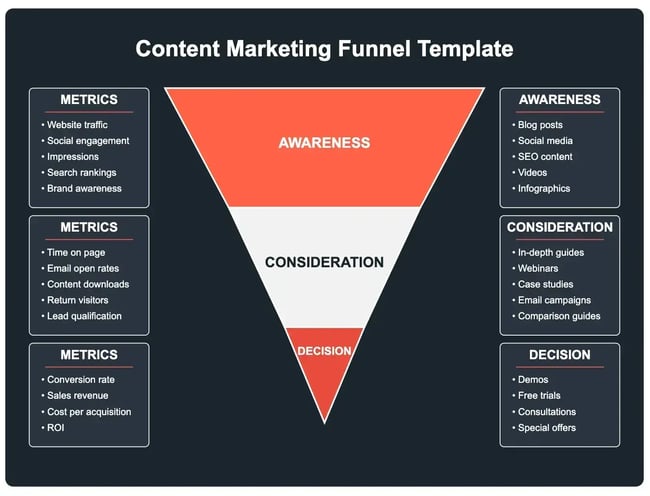
By understanding how different personas research and evaluate, you can build content for every funnel stage that supports their journey from start to finish.
Content Ideas for Each Stage of the Buyer's Journey

ToFu: Awareness
At the top, people are exploring. They might know they have a problem or just be curious about a topic — but they're not ready for a sales pitch. Awareness is where I lead with helpful, non-promotional content that builds trust and gets our brand on their radar.
In my experience, ToFu content performs best on:
- Blog (via SEO or newsletter)
- Social media (LinkedIn for B2B)
- YouTube
- Podcasts
- Third-party media ( PR hits or guest features)

I don‘t expect conversions here — that’s not the point. But I’ll call it a win if someone remembers who helped them when they were stuck.
Here are a few types of TOFU content that I’ve seen consistently attract the right audience — and how to get the most out of each one.
1. Blog Post
Blog posts are ideal for the awareness stage. By addressing pain points your audience actively researches, you create valuable, discoverable resources that build your content for every funnel stage strategy.
“People may need your product but don’t always realize it,” says Natallia Slimani, content manager at time tracking software Traqq. “For example, people might search for productivity tips or remote work advice before they even know they need a time tracker.”
One successful post Traqq published covered calculating time differences in Excel — a common challenge for their remote-working audience. It's educational and helpful, naturally surfacing Traqq as a solution without becoming a sales pitch.

Pro tip: When I'm stuck brainstorming blog topics aligned with audience pain points, HubSpot's Blog Ideas Generator helps spark ideas. Just plug in keywords and let it generate relevant titles.
Featured Resource: Free Blog Post Templates
2. Social Media Post
Social media is powerful for ToFu — especially for B2B audiences. With over 86% of adults on at least one social platform, your audience is almost certainly scrolling somewhere online.
Since I work primarily with B2B SaaS clients, LinkedIn is my go-to. It's where decision-makers hang out, and where helpful, context-rich posts gain traction.
Research shows LinkedIn carousel ads beat static formats in engagement because they let you tell visually-driven stories slide by slide. Even for organic content, carousel-style posts work well because they break complex ideas into bite-sized slides.
Carousel-style posts allow you to break complex ideas into bite-sized slides. You can use formats like:
- Quick “5-step checklist” for content planning
- Mini-case study with problem → outcome on separate slides
- Bite-sized myth-buster series that challenges assumptions
Pro tip: Start with a repurposed blog insight or stat, design a PDF with a clear hook and clean visuals, and upload it as a document post on LinkedIn. Even simple Canva slides work well.
3. Whitepaper
Whitepapers establish thought leadership without massive budgets. These comprehensive reports (typically 5–20 pages) combine original research, industry insights, and practical recommendations to address specific business challenges.
LinkedIn's 2025 Workplace Learning Report exemplifies this perfectly — a global study surveying over 1,600 L&D professionals, delivering actionable insights on learning engagement trends without pushing LinkedIn Learning upfront.

Why it works:
- Most HR teams deal with the same headaches around employee development
- They used actual survey data and user stats, not just opinions
- You get through most of the report before realizing LinkedIn has a learning product
Creating a whitepaper isn‘t something only big companies can do. At one company, I took our annual customer satisfaction survey and turned it into a report about remote work trends. Another time, we analyzed our support tickets and found patterns that became an industry whitepaper. The trick is looking at information you’re already collecting and figuring out what story it tells about your industry.
And remember, the impact doesn’t stop at the PDF. I always repurpose the content into blog posts, LinkedIn carousels, email snippets — all driving traffic back to the main piece.
4. Checklist
When a task feels overwhelming, checklists make it doable. You‘re not just helping your audience stay organized — you’re giving them the confidence to take action.
Moz has a great SEO Audit Checklist that walks through what to check and why it matters. It covers essentials like crawlability, on-page SEO, and link analysis — all in a format that’s useful and easy to follow.
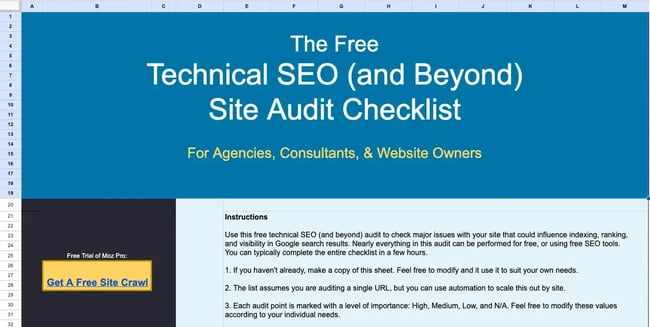
I’ve seen checklists like this work exceptionally well when a process has lots of moving parts. They're fantastic top-of-funnel resources because they give audiences quick wins — no strings attached — while building trust.
5. How-To Video
Sometimes, the best way to solve a problem is learning new skills. That’s where how-to videos shine — especially in the awareness stage.
HubSpot’s YouTube channel is packed with educational videos helping marketers level up. One recent favorite covers finding your target audience in 2025, walking through a six-step framework with a free template.
If you‘re trying to reach people who don’t know they need your product yet, how-to videos are great starting points. They build trust, provide real value, and set the stage for deeper engagement later.
6. Kit or Tool
Sometimes, early-stage prospects don’t want a deep-dive report — they want shortcuts. Simple tools or templates help them get started faster, and that utility builds brand trust.
Notion does this well with its Marketing Project Brief — a free template helping marketers organize campaigns, key messages, and metrics in one place.
Why it works:
- Solves a real problem for marketers: aligning multiple stakeholders
- Ready to use with zero friction to get started
- Showcases Notion’s value through firsthand product experience

I've worked with clients on similar templates — campaign budget planners, messaging frameworks, and onboarding checklists. These tools drive sign-ups and become evergreen lead magnets that deliver value long after launch.
7. Ebook or Tip Sheet
Sometimes audiences need more than quick blog posts but aren't ready for whitepapers. Ebooks and tip sheets bridge that gap — long enough for real value, short enough to stay approachable.
Hootsuite’s “What is Social Media Marketing?” guide breaks down the fundamentals in ways that work whether readers skim or study deeply, explaining core concepts without assuming expertise.
Why it works:
- Explains concepts without assuming deep expertise
- Organized clearly with visual examples and short takeaways
- Introduces key challenges before mentioning the platform

I've seen ebooks like this work well as gated content for growing your email list — especially when paired with a lead magnet that promises something specific (“Get the seven strategies top brands use to grow on social”). And later, you can slice it up into blog posts, LinkedIn carousels, and newsletter content.
Featured Resource: 36 Free Ebook Templates
8. Educational Webinar
I like webinars because you get to have actual conversations with your audience. I‘ve run both live sessions and pre-recorded ones, and what works well is that people join expecting to learn something practical— they’re not there to be sold to.
When you bring in guest experts or dive into industry challenges, you build credibility before you ever talk about what you're selling.
Canva's recent webinar series brought in CMOs from HubSpot and Stripe to talk about marketing efficiency. Instead of just having Canva people present, they created panel discussions about real problems like using AI in marketing campaigns and managing creative teams at scale.
What made it smart:
- Having outside executives meant it didn't feel like a Canva sales pitch
- They focused on topics marketers are struggling with right now
- One webinar became multiple blog posts, social content, and email newsletters

I've run similar webinars using simple platforms like Zoom with solid slide decks. Success comes from expert content and format, not complexity. Well-delivered sessions on useful topics fuel multiple follow-ups and keep brands top of mind.
MoFu: Consideration
Once someone knows who you are, it’s all about deepening the relationship. Middle-funnel content nurtures leads, builds trust, and helps audiences evaluate options — including your product or service. Think of it as the helpful, no-pressure friend who points someone toward a smart next step.
This stage tends to involve more extended engagement. You’re not just grabbing attention anymore — you’re establishing credibility and guiding people toward decisions without hard selling.
In my experience, MOFU content works well across:
- Blog (especially gated or longer-form content)
- Email marketing
- Webinars
- Case studies or customer success hubs
- Product pages or comparison pages

Let’s take a look at the types of content that help move someone from curious to seriously considering your solution.
1. Product Comparison Guides
When someone’s weighing options, good comparison guides can be the difference between them choosing you or clicking away. I’ve created a lot of these for clients in competitive industries, and I’ve learned that the best ones don’t just highlight what makes your product great — they highlight what makes it great for a specific buyer type.
I always start with the real pain points I know the audience is facing. Then, instead of just rattling off a list of features, I walk through how each solution — ours and the alternatives — tackles those problems. That structure makes it easier for the reader to self-identify and feel confident in their choices.
Kevin Dam, CEO and founder of Aemorph, explained his team’s approach:
“We didn't just list features; we also answered common complaints, added case studies, and made the call to action strong. The page did better than competitors and had a 30% higher sales rate than a normal product page.”
Here’s how I approach it:
- Use plain language, not marketing jargon. No one wants to decipher buzzwords when they’re trying to make a decision.
- Be honest about trade-offs. A buyer who feels like you’re giving them the whole picture is more likely to trust you.
- Add in mini case study snippets or testimonials to reinforce each differentiator.
Comparison guides are some of the most valuable MoFu content you can create — but only if they’re genuinely helpful. I think of them less like sales tools and more like decision tools. When done right, they do both.
2. Case Study
When someone’s in the consideration phase, they’re not just asking, “Does this product work?” — they’re asking, “Will it work for my situation?” That’s where well-executed case studies shine.
I‘ve seen case studies work best when they follow a simple story: here’s what was broken, here‘s what we did, and here’s what happened. You‘re not trying to make everything sound perfect — you’re just being honest about what changed.
Here’s how I structure case studies:
- Focus on relatable problems audiences likely face
- Include tangible, metrics-backed results
- Use real customer quotes, making stories personal and believable
Asana's case study with Zoom shows how they brought visibility and efficiency to IT workflows. Results are concrete: 667 workdays saved annually, over 90% program adoption, and smoother collaboration between technical and nontechnical teams.
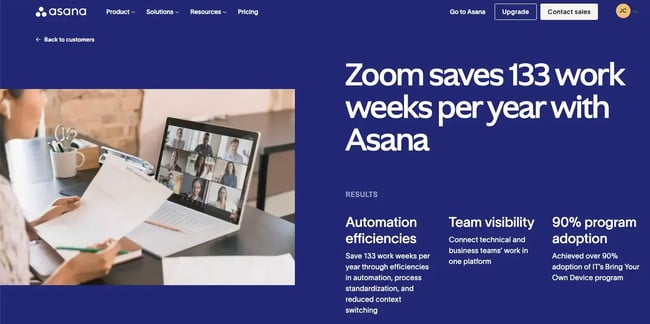
What makes it effective isn’t just the outcome — it’s how the story connects with pain points that buyers navigate in this stage.
Featured Resource: 3 Free Case Study Templates
3. Free Sample
Some products you just need to experience firsthand before you commit to buying them. That’s what makes free samples clever consideration-stage tactics, especially for physical products or anything that benefits from hands-on experience.
Take VistaPrint’s free business sample kit. It includes examples of business cards, brochures, and other print materials, giving prospective customers a feel for the quality before they commit. For tactile products like print, digital content alone can’t always close deals — but once someone holds the product in their hands, that final decision gets easier.
I’ve seen this work best when samples are:
- Easy to request (no hoops to jump through)
- Aligned with what buyers evaluate
- Useful even without an immediate purchase

While free samples aren’t as common in B2B SaaS, the same principle applies. I've worked on similar offers at companies where we provided limited access to templates, toolkits, or starter dashboards — bite-sized versions of the real thing that show the product’s value without a full trial.
BoFu: Decision
Once someone reaches the decision stage, they’ve likely narrowed their options. They’ve done the research — now they’re looking for validation and reasons to feel confident about their choice.

At this point, I focus on removing remaining hesitation. That means answering objections, showcasing value clearly, and making next steps as easy as possible. The goal isn‘t pushing — it’s making decisions feel like no-brainers.
Most effective channels for BoFu content:
- Website (especially product and pricing pages)
- Email marketing
- Live chat or chatbot support
Here are the types of content I rely on to help close the gap between consideration and conversion.
1. Free Trial or Live Demo
At the decision stage, one of the best conversion tactics is letting prospects experience products themselves. Free trials and live demos give buyers chances to see products in action without sales pressure.
Free trials work exceptionally well for B2B SaaS, where users can explore features independently and visualize how products fit workflows. Live demos let teams walk through tools with prospects, answer specific questions, and tailor pitches to their needs.
Buffer is an excellent example of this approach. While the company offers a free plan, it also encourages users to start premium feature trials. Its pricing page reduces confusion and makes the next steps easy.
%2c%20and%20team%20($10month)%20plans.%20each%20plan%20highlights%20features%20like%20scheduled%20posts%2c%20ai%20assistant%2c%20analytics%2c%20and%20user%20accounts..webp?width=650&height=450&name=buffer%20pricing%20comparison%20chart%20for%20free%2c%20essentials%20($5month)%2c%20and%20team%20($10month)%20plans.%20each%20plan%20highlights%20features%20like%20scheduled%20posts%2c%20ai%20assistant%2c%20analytics%2c%20and%20user%20accounts..webp)
I’ve seen teams boost conversion by pairing trials or demos with decision-stage content like ROI calculators, product guides, or customer stories.
That’s what the team at emma, a cloud management platform, did when they noticed prospects hesitating over price.
Dirk Alshuth, CMO at emma, explains: “Potential customers often hesitated due to pricing concerns, so we built a tool that showed exactly how much time and money they could save. This worked because it tackled a major purchasing objection with real, personalized data. It increased demo requests by 35% because prospects could clearly see the value of our product before even speaking to sales.”
2. Consultation Offer
Not every prospect is ready to dive into a product on their own — sometimes, they want to talk to a real person first. That’s where a consultation offer can help bridge the gap.
In B2B, especially with more complex solutions, I’ve found free consultations build trust and create a natural next step for buyers who still have questions. It’s not just about pitching — it’s offering practical guidance in exchange for their time.
When I recommend consultation offers, I focus on:
- Making scheduling easy with tools like Calendly or HubSpot meeting links
- Being clear about what consultations include and what buyers can expect
- Highlighting the expertise of those they'll speak with
This format works particularly well when buyers weigh multiple providers and want tailored advice. Framing sessions as helpful, no-pressure conversations often lowers barriers and improves conversion rates.
3. Coupon
Coupons appeal to a fear of missing out (FOMO) mindset. By reducing prices, coupons handle price objections while convincing prospects they‘re leaving money on the table if they don’t act. This inertia is often enough to win business.
Research shows 62% of U.S. consumers actively look for promo codes when shopping online, making timely incentives powerful conversion tools.
Lovevery, which sells stage-based play kits for child development, offers $10 off first orders in exchange for email addresses and children‘s birth dates. This pop-up drives conversions while personalizing experiences for each family’s needs.

I’ve seen similar tactics work in B2B, too. Things like early-adopter pricing, limited-time bundles, or promotional discounts tied to specific campaigns can help reduce friction without devaluing your product. The key is making offers relevant, time-sensitive, and easy to act on — delivering them when intent is high.
Mapping Content Across All Stages of the Buying Cycle
In my experience, content strategy falls apart when it only focuses on one part of the funnel. I’ve seen brands go all-in on blog posts and awareness assets but miss the trust-building and conversion-focused content that moves buyers forward.
That’s why I always map content across the entire buyer’s journey — not just by funnel stage, but by how people make decisions. The goal isn’t overloading every channel with content. It's ensuring you cover each stage with something genuinely helpful.
Regardless of model, the approach stays the same:
- Understand buyer questions, doubts, and goals at each stage
- Align content to those needs
- Deliver through the right channels at the right time
When I get this right, conversion rates improve, but that‘s not even the best part. What I notice is that customers seem happier from the start — they know what they’re getting into and feel good about their choice. That's what smart content strategy should do.
Editor's note: This post was originally published in August 2016 and has been updated for comprehensiveness.
Content Marketing

-1.webp)




![How to create a content style guide [+ free guide & examples]](https://53.fs1.hubspotusercontent-na1.net/hubfs/53/image1-May-07-2024-07-15-58-1152-PM.webp)
